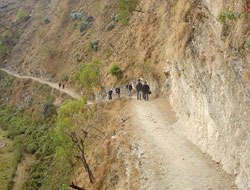|
|
| REVOLUTIONARY TREK: The trail from Tila and Thalsang under a foot of snow last month. |
For a decade now, Nepal's tourism entrepreneurs have thought of tourism in terms of trekking to Khumbu, sightseeing in Kathmandu, and boating on Phewa.
It's time to push the envelope and define adventure tourism in a whole new way. Some trekking groups are already travelling to Rolpa and Rukum to combine trekking with the publicity generated by Nepal's Maoist insurgency. Even during the conflict, trekkers used to look forward to encounters with Maoists and took home receipts of Maoist 'revolutionary tax' as souvenirs.
"There is a surprising level of interest in visiting these areas," says a Japanese tour leader, "people want to know what it looks like in a Maoist base area."
Contrary to the belief that most tourists are cautious, trekking agencies in Kathmandu specialising in French and Japanese tourists say they have lots of queries about visiting mid-western Nepal or other regions like Rara, Dhorpatan, and Phoksundo that were out of bounds because of the insurgency.
Because of the ceasefire, bookings are strong this year for off-the-beaten trek destinations like Budi Gandaki, Manasulu circuit, and Kangchenjunga, which had seen a sharp drop in visitors because of the conflict.
To be sure, the facilities on the Rolpa trek can be rudimentary-a bit like the Langtang trail 20 years ago. Even so, the terrain is harsh but spectacularly scenic, especially with the unprecedented snowfall this winter. The people are unexposed to the outside world in this remote area and therefore very hospitable.
|
|
Taking a bus from Dang up to Tila, it is a two day walk to Thabang. This is the cradle of the Maoist revolution and was partially flattened in aerial bombardment by the army in 2002. A road is being built to Thabang, and it may be good idea to get to go there before the road does.
The road has several landslides because of construction, but the route has some dramatic vantage points for scenery. There are private tea houses, and also Maoist-run cooperatives, which offer food and lodging, but no beer or alcohol.
Food is cheaper here than most parts of rural Nepal: Rs 35 for a plate of rice and vegetables and overnight lodging is usually free if you eat in the shop.
"During the war, the party paid us to feed the guerrillas and cadre who passed through," remembers Comrade Zamana who runs a cooperative restaurant, "but now we have to run it like a business. It would be good if more tourists came through."
When we get to Thabang, we asked Comrade Inkar, the town's Maoist headman, if Americans are welcome. "Why not," he replied, "we will welcome them like we have welcomed them in the past." Suddenly turning serious, he added: "But their intention should be pure." Inkar said lots of foreigners including Americans have visited Thabang, but admitted most of them were journalists.
The Maoists are trying to make the revolution itself a tourist attraction, and Inkar tells us Thabang is being established as a model commune. Phone lines have been repaired and there will soon be electricity in Thabang.
Just like Mao-chic has become a tourist attraction in China, Rolpa's revolutionary songs and dances can also bring employment and income to local cultural troupes. After all, Rolpa has everything: scenic mountains, a rich folk tradition, and revolution.




